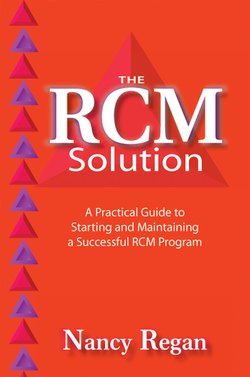Читать книгу The RCM Solution - Nancy Regan - Страница 6
На сайте Литреса книга снята с продажи.
ОглавлениеTable of Contents
Cover
Title Page
Copyright
Dedication
Acknowledgements
Preface
1.Introduction to Reliability Centered Maintenance
1.1What is RCM?
1.2Elements that Influence a System
1.3The Essence of RCM: Managing the Consequences of Failure
1.4What RCM Can Yield
1.5The Evolution of RCM Principles
1.6The Development of RCM Principles
1.7Definition of RCM
1.8Defining Performance in the Context of RCM
1.9Introduction to the RCM Process
1.10Failure Modes and Effects Analysis (FMEA) and Failure Modes, Effects, and Criticality Analysis (FMECA)
Summary
2.A Facilitated Working Group Approach to RCM
2.1The Team Approach to Accomplishing Objectives
2.2Elements that Influence a System
2.3Failure Management Strategies
2.4Historical Data and the RCM Process
2.5Effective Working Groups
2.6Benefits of a Facilitated Working Group Approach
Summary
3.The RCM Operating Context
3.1What Is an Operating Context?
3.2When Should an Operating Context Be Drafted?
3.3What is Included in an Operating Context?
3.4The Operating Context as a Living Document
Summary
4.Functions
4.1Why Write Functions?
4.2Two Types of Functions
4.3Classifying Functions as Evident or Hidden
4.4Composing Evident and Hidden Functions
4.5Information Worksheet
4.6Primary Functions
4.7Secondary Functions
4.8General Equipment Features that Typically Warrant Secondary Functions
4.9Tips Regarding Functions
Summary
5.Functional Failures
5.1What Is a Functional Failure?
5.2Two Types of Functional Failures
5.3Composing Functional Failures
Summary
6.Failure Modes
6.1What Is a Failure Mode?
6.2Failure Modes and the Information Worksheet
6.3Composing Failure Modes
6.4What Failure Modes Should Be Included in an RCM Analysis?
6.5How Detailed Should Failure Modes Be Written?
6.6Identifying Failure Modes for Each Functional Failure
6.7Tips for writing Failure Modes
Summary
7.Failure Effects
7.1What Is a Failure Effect?
7.2Failure Effects and the Information Worksheet
7.3Composing Failure Effects
7.4Writing Failure Effects for Protective Devices
Summary
8.Failure Consequences
8.1What Is a Failure Consequence?
8.2Introduction to the Decision Diagram
8.3Classifying Failure Modes as Evident or Hidden
8.4Identifying Failure Consequences
Summary
9.Proactive Maintenance and Intervals
9.1Proactive Maintenance in the Context of RCM
9.2Criteria for Assigning a Proactive Maintenance Task
9.3Scheduled Restoration and Scheduled Replacement Tasks
9.4On-Condition Tasks
9.5Combination of Tasks
9.6Synchronizing Initial Task Intervals
Summary
10.Default Strategies
10.1Procedural Checks
10.2Failure Finding Tasks
10.3Synchronizing Initial Task Intervals
10.4No Scheduled Maintenance
10.5Other Default Strategies
10.6Important Notes Regarding Default Strategies
Summary
11.Analysis Validation and Implementation
11.1Frequently-Asked Questions About the Validation Process
11.2Implementing RCM Analysis Results
Summary
12.How to Initiate and Successfully Sustain an RCM Program
12.1The Steps to Initiate an RCM Program
12.2Sustaining an RCM Program
Summary
13.Frequently Asked Questions and Common Misconceptions about RCM
13.1RCM FAQs
13.2Common Misconceptions Regarding the RCM Process
14.RCM Is Only Part of the Solution
14.1Two Fundamental Realities of Asset Management
14.2The Application of Processes Less Robust than RCM
14.3The RCM Solution
Summary
Appendices:
Steps to Initiate an RCM Program
Steps to Successfully Complete RCM Pilot Projects
Glossary
Bibliography
Index
